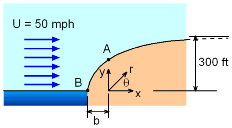| Ch 7. Incompressible and Inviscid Flow | Multimedia Engineering Fluids | ||||||
|
Bernoulli's Equation |
Flow Measurements |
Superposition of Flows |
Flow around Cylinder |
||||
| Superposition of Flows | Case Intro | Theory | Case Solution | Example |
| Chapter |
| 1. Basics |
| 2. Fluid Statics |
| 3. Kinematics |
| 4. Laws (Integral) |
| 5. Laws (Diff.) |
| 6. Modeling/Similitude |
| 7. Inviscid |
| 8. Viscous |
| 9. External Flow |
| 10. Open-Channel |
| Appendix |
| Basic Math |
| Units |
| Basic Fluid Eqs |
| Water/Air Tables |
| Sections |
| eBooks |
| Dynamics |
| Fluids |
| Math |
| Mechanics |
| Statics |
| Thermodynamics |
| ©Kurt Gramoll |
|
|
||
|
|
The present problem is solved using the potential flow past a half-body. As shown in the theory section, the magnitude of the velocity at any point is given by To determine the actual wind speed at any point along the surface, variables b, r and θ need to be determined. Note that b is the distance between the source and the stagnation point (see theory section). The stagnation point (i.e., point B) is given by θ = π and rstagnation = b = m/2π U and the stream function at this point is ψstagnation = πbU The stream function that passes through the stagnation point and along the hill, is then obtained as ψ = πbU = U r sinθ + b U θ which can be rearranged to give r = b(π - θ)/sinθ or y = b(π - θ) |
|
 Velocity Variation on Half-body Surface |
The above expression gives the radius location along the hill. Note that as θ approaches 0 (i.e., towards inland), y approaches πb. For this problem, πb becomes 300 ft. Thus, b equals 300/π. At the proposed site (i.e., point A), θA is π/2, and the radius (rA) is determined to be πb/2. The velocity at point A is then calculated as VA = 59.27 mph The velocity for all angles is given at the left. Notice, the velocity is zero at the front stagnation point, and rises to a maximum at about 120 degrees. the downstream final velocity will be the same as the initial velocity, 50 mph. |
|
Practice Homework and Test problems now available in the 'Eng Fluids' mobile app
Includes over 250 free problems with complete detailed solutions.
Available at the Google Play Store and Apple App Store.


